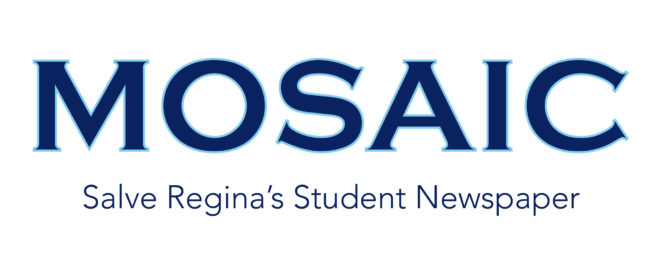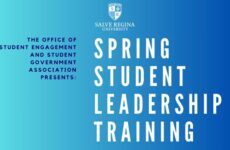By Marrissa Ballard | Managing Editor
It was on a cold but sunny day that a group of students assembled themselves in a parking lot as they prepared to circle Salve Regina’s campus. Some students dressed in a bra and shorts while others dressed in shirts and jeans. Patricia Socarras, a freshman at the time, was wearing a suit for her Student Government campaign. She carried a sign that read “Real men respect women.” The group chanted, sang, and held other signs painted with slurs like “slut” and “whore.” The protesters also posted signs on the walls in academic buildings. This was Salve’s first SlutWalk, and it was one of the largest protests to ever happen on campus.
Socarras, now a seasoned junior at Salve, recalls the SlutWalk as a poignant moment in her time at Salve. “It was powerful to be with people who are fighting for social equality,” Socarras states.
However, a protest called the ‘SlutWalk’ was bound to cause controversy at a private, Catholic school like Salve. “It was a point of contention,” Socarras admits. “People didn’t think the university should be allowing or promoting this kind of event.”
Some of the anger inspired by the protest was expressed publicly. A professor who wishes to remain anonymous states that he saw a member of Salve’s administration tearing down the protesters’ signs. “I asked her what she was doing,” he says. “She told me that such messages would damage the school’s reputation.” Even now, two years later, the professor says he still does not understand how an educator could justify muting the opinions of students.
Though the SlutWalk was a new experience for the Salve community, student protests are not a new occurrence. Dr. Anthony LoPresti, a professor at Salve who teaches a class on protests, says that the 1960s and 1970s show many examples of student involved protests. According to LoPresti, civil rights, feminist, and anti-war protests were often attended and even organized by students. He cites the example of the 1968 protest at Colombia University, during which students took over academic buildings and went on strike. “They had to cancel the rest of the spring semester because students weren’t coming to class,” LoPresti explains.
In the past year alone, there has been a resurgence of large student-led protests on campuses such as the University of Missouri and Yale University. In her article, “Student Activism is Serious Business,” activist Roxane Gay notes that in the protests at Missouri and Yale, students have made it clear that “the status quo is unbearable.” Similarly, the SlutWalk at Salve was a protest against the prevalence of gender inequality and sexual violence on campuses.
Salve’s administration responded to the SlutWalk with the creation of a Protest and Demonstration Policy and Committee. The committee includes faculty, staff, and student representatives. The policy, which can be found in the student handbook, states that students organizing a protest should register it three days in advance and submit a form to the Dean of Students office. According to the policy, the committee hopes to advise students on “maximizing the effectiveness” of their protests.
Dean Malcolm Smith, who wrote the policy and assembled the committee, emphasizes that the committee does not approve or deny protest registrations. Students can still protest spontaneously. In general, Smith states that he is a huge supporter of protests. “They give students a chance to challenge any element of society, and that’s why they’re a beautiful thing,” states Smith.
Smith also believes that the university should “bolster” protests with more information. “There are ways to appropriately educate our students on how to use their voice when they oppose something,” Smith states. “I think the registration process and policy is there to resource people, not to stop them.”
However, Smith is also dedicated to protecting the academic pursuits of all students, and this includes protection from disruptions. “Campuses have every right to protect the academic mission of a university,” Smith explains.
Jennifer Jensen, the chair of the committee, also believes that the protest committee should aim to protect against both academic and emotional disruptions. In looking at a protest, Jensen might ask questions like “Did it offend other students in the process? Because those students are also a part of our community.”
The aim of the policy, according to Jensen, is to help students with the “when, where, and how” details of their protest. “We don’t want them to do it in O’Hare in the middle of classes, because now your right to free speech is impacting someone’s education,” Jensen states.
Jensen could not be specific about what would happen if students did not want to comply with the registration or refused to be advised on how or where they should hold their protest. Since the committee has not experienced that yet, Jensen speculated that any time there was an issue they would call both the committee and the students together for a dialogue. According to Jensen, in the two years since the committee was created it has only received four registration forms and none of them necessitated any form of intervention.
Patricia Socarras, as a past protester herself, explains that when the policy and committee was created, she was confused. “I thought ‘we should be able to assemble, I don’t understand why we have to regulate it,’” Socarras says. “But in looking at the policy, I understand that it is to keep both the protesters and the people who might think the protesters are in the wrong safe. I don’t have any objections to it now.”
However, other members of the Salve community see issues with the policy. Dr. LoPresti, a member of the committee, feels that the policy could be discouraging protests on an already quiet campus. “The challenge here at Salve is to rile students up,” he says. “Students don’t want to make waves and they err on the side of caution.” In his opinion, it would be okay to grant students “more freedom” in order to inspire more activism at Salve.
In order to motivate students at Salve, LoPresti asks members in his class to pick an issue and organize a protest on their own. For example, in December a group from his class organized a protest against the high cost of textbooks. “In general if someone is protesting, they’re probably in my class,” LoPresti explains.
LoPresti also disagrees with the part of the policies that aim to protect against disruptions. “I think it’s a greater good that we empower our students to speak up about injustices than it is to protect other students and professors from being disrupted,” LoPresti states. “Protests are supposed to be disruptive.”
Rather than policing protests, LoPresti believes instead that the university should be encouraging students to use their voices. “If we want to teach students to protest, if we want to teach them to make a difference in society, I think we need to give them incentives to do that, and not threaten to penalize them,” LoPresti says.
In part, LoPresti cites his support for protests with Salve’s mission statement. “The mission statement says we are to work for a world that’s harmonious, just and merciful.” LoPresti states. “We wouldn’t need to say that if the world were already harmonious, just, and merciful.”
Dr. Jordan Miller, a Religious Studies professor who concentrates on religion and activism, also sees problems with Salve’s new policy. Like LoPresti, Miller mentions Salve’s mission statement as a defense of protest. However, while the values of justice and harmony are part of the university’s mission, Miller believes it is important to understand that “justice isn’t always nice, it isn’t always polite, nor should it be.” Miller also points out that “harmonious doesn’t necessarily mean pleasing.”
According to Miller, it is not surprising that the policy and committee was created in response to the SlutWalk. “In a certain sense, it’s a mark of success,” Miller states. “Real protest bothers people, that’s what makes it protest.”
In general, Miller defines the Protest Committee as a “bureaucratic process” that could be expected from any university. “Rather than saying no outright, the university would put it in committee,” Miller explains.
Miller also believes the policy should be transparent about what would happen if students refuse to register. “The lack of transparency about all of this suggests that the point of the policy isn’t to know what’s going on but rather to discourage radical activity,” Miller states.
“A non-sanctioned protest at Salve would problematize that and it would force the administration of the university to deal with it,” Miller states. “Therefore, freedom of expression is also freedom of disobedience.”
Even though the committee does not approve or deny protests, Miller thinks that “it still serves as a bureaucratic hindrance” in that it slows down the protest process.
“That may or may not be a good thing. On the one hand, it forces students not to act rashly and to be thoughtful about what they might do and why. On the other hand, it serves to dissuade students from doing something that may be offensive,” Miller explains. “In other words, it has the potential to stand in the way of students expressing their dissatisfaction with something: the precise reason for the protest in the first place.”













